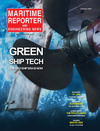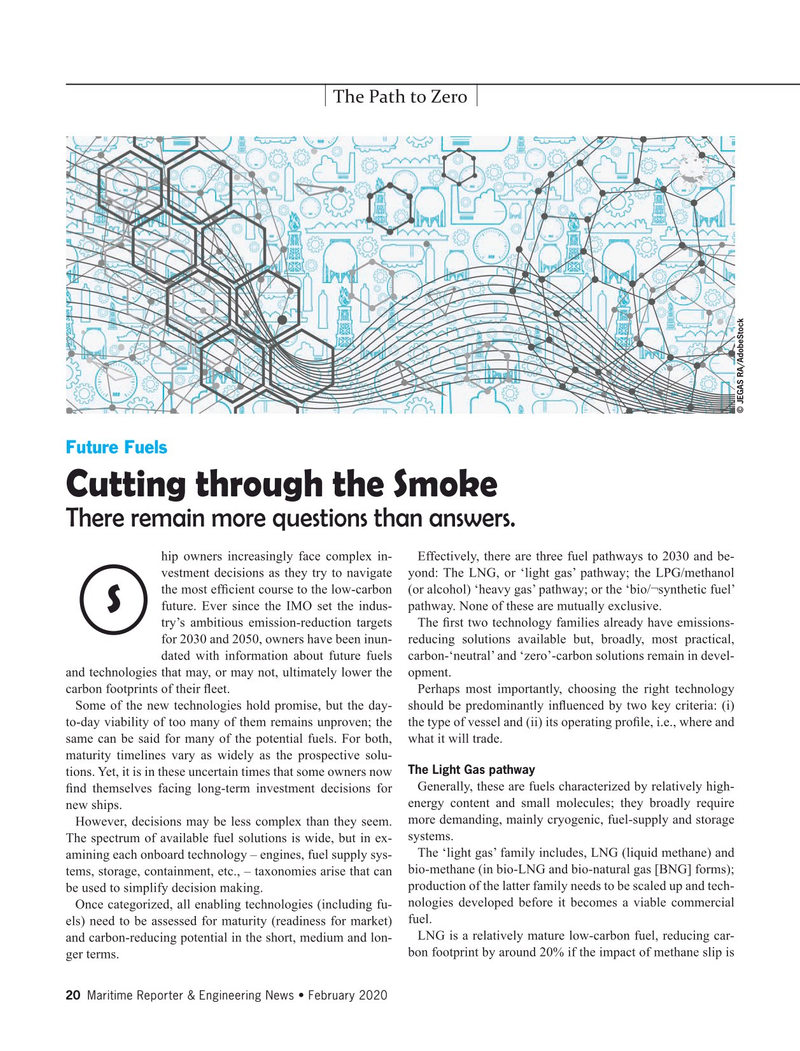
Page 20: of Maritime Reporter Magazine (February 2020)
Green Ship Technology
Read this page in Pdf, Flash or Html5 edition of February 2020 Maritime Reporter Magazine
The Path to Zero © JEGAS RA/AdobeStock
Future Fuels
Cutting through the Smoke
There remain more questions than answers.
hip owners increasingly face complex in- Effectively, there are three fuel pathways to 2030 and be- vestment decisions as they try to navigate yond: The LNG, or ‘light gas’ pathway; the LPG/methanol the most ef? cient course to the low-carbon (or alcohol) ‘heavy gas’ pathway; or the ‘bio/¬synthetic fuel’ future. Ever since the IMO set the indus- pathway. None of these are mutually exclusive.
S try’s ambitious emission-reduction targets The ? rst two technology families already have emissions- for 2030 and 2050, owners have been inun- reducing solutions available but, broadly, most practical, dated with information about future fuels carbon-‘neutral’ and ‘zero’-carbon solutions remain in devel- and technologies that may, or may not, ultimately lower the opment.
carbon footprints of their ? eet. Perhaps most importantly, choosing the right technology
Some of the new technologies hold promise, but the day- should be predominantly in? uenced by two key criteria: (i) to-day viability of too many of them remains unproven; the the type of vessel and (ii) its operating pro? le, i.e., where and same can be said for many of the potential fuels. For both, what it will trade. maturity timelines vary as widely as the prospective solu-
The Light Gas pathway tions. Yet, it is in these uncertain times that some owners now
Generally, these are fuels characterized by relatively high- ? nd themselves facing long-term investment decisions for energy content and small molecules; they broadly require new ships.
However, decisions may be less complex than they seem. more demanding, mainly cryogenic, fuel-supply and storage systems.
The spectrum of available fuel solutions is wide, but in ex-
The ‘light gas’ family includes, LNG (liquid methane) and amining each onboard technology – engines, fuel supply sys- tems, storage, containment, etc., – taxonomies arise that can bio-methane (in bio-LNG and bio-natural gas [BNG] forms); production of the latter family needs to be scaled up and tech- be used to simplify decision making.
nologies developed before it becomes a viable commercial
Once categorized, all enabling technologies (including fu- els) need to be assessed for maturity (readiness for market) fuel.
LNG is a relatively mature low-carbon fuel, reducing car- and carbon-reducing potential in the short, medium and lon- bon footprint by around 20% if the impact of methane slip is ger terms.
20 Maritime Reporter & Engineering News • February 2020
MR #2 (18-33).indd 20 2/5/2020 10:51:17 AM

 19
19

 21
21
